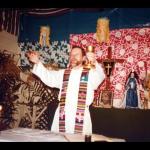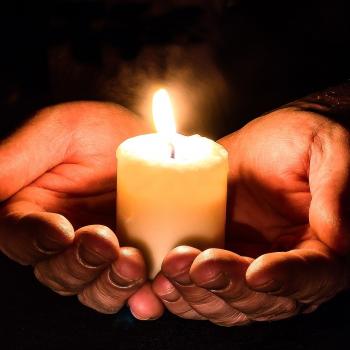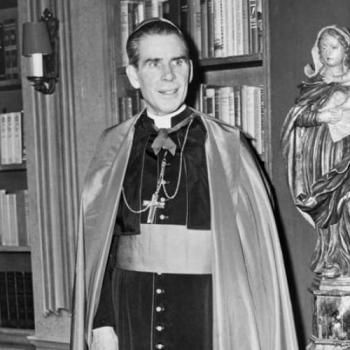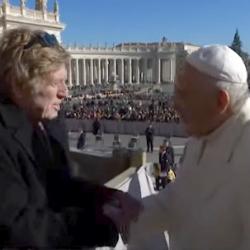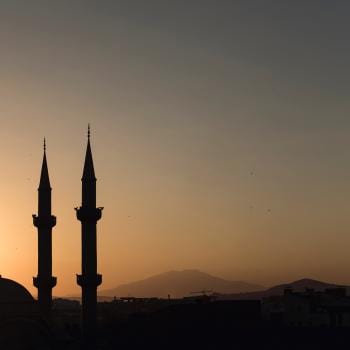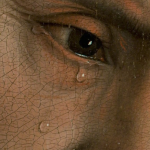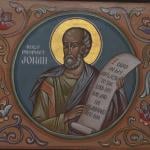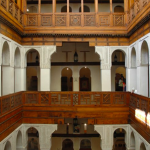So I’m up here in Québec for the Catholic Media Conference, and was privileged to attend Mass Wednesday night celebrated by Canada’s primate, the cardinal archbishop of Québec, Gerard Lacroix.
First, the setting was the city’s lovely cathedral, Notre Dame de Québec.
[img attachment=”210315″ align=”aligncenter” size=”full” /]
It’s undergoing some renovation inside, so the main altar was covered by an enormous scrim bearing a photograph of the sanctuary.
[img attachment=”210316″ align=”aligncenter” size=”full” /]
The ceiling is simply beautiful: a glimpse of heaven.
[img attachment=”210317″ align=”aligncenter” size=”full” /]
But the main attraction, for me, was the cardinal, who celebrated Mass in three languages—French, English and Spanish—and preached eloquently about Catholic communications, tying it to his own experience as a missionary.
[img attachment=”210318″ align=”aligncenter” size=”full” /]
In a poignant and powerful gesture, he also used for the Mass a chalice given to the first bishop of Québec, St. François de Laval, by the king of France over 300 years ago.
[img attachment=”210320″ align=”aligncenter” size=”full” /]
He’s an impressive and gregarious presence—a happy priest. In a timely coincidence, America magazine published this week an interview with this happy priest that gives more background about his remarkable life:
Cardinal Lacroix came to Rome as archbishop of Quebec when Francis was elected pope. He recalled watching his first appearance on the balcony of St. Peter’s and “when I saw the Holy Father of the Roman Catholic Church, come out on that balcony in his white cassock and ask people to pray for him and then bow down before the people, I said ‘this is my man.’ I was profoundly touched by his simplicity.”
He feels “very much in communion” with the Jesuit pope. At the same time, he said: “I’m very different to him. I mean, he’s a scholar. I’m a son of a lumberjack. I’m not a scholar. But on a pastoral level, I am with him. As pastors, we are called to love the world as Jesus did, and that is what Francis is doing.”
He spent nine years working among the poor in Colombia in 1990:
On arrival in Colombia, he along with two young men and a woman who joined him went to talk with the bishop of the Diocese of Popayán, 350 miles southwest of Bogotà. He opened a huge map of the diocese on the table and pointed to 12 parishes that did not have a priest, some in nice zones, others on the outskirts and one “very, very poor parish in a war zone, where there were a lot of guerrillas, that had not had a priest in five years.” Father Lacroix said they would go wherever he thought best. The bishop assigned them to the war zone.
When they arrived at the parish there was the equivalent of five dollars in savings, but they were not discouraged; they had come to serve these people and were confident things would work out. They spent the first six months improving their Spanish and learning the local customs.
“Every night we’d celebrate Mass at 7 p.m.,” the cardinal recalled. “There was no electricity. We used candles and the like. The church was packed with kids, young people, adults, old people; every day they’d come to Mass. They were so thirsty to hear the word of God and so happy to be together to celebrate.”
There were 85 villages in the parish. The furthest away were 18 hours on the back of a mule—and there was no other transportation.
Read it all. He strikes me as a Franciscan bishop, in every sense, and a man who could have a profound impact on the Church in Canada—or, indeed, around the world.
Finally, it’s worth noting: one of the people who attended the Mass was none other than director Martin Scorsese. After the liturgy, he joined some 500 of us for dinner, and received a lifetime achievement award from SIGNIS—a lay ecclesial group of Catholic media professionals—and the Catholic Press Association.
[img attachment=”210330″ align=”aligncenter” size=”full” /]
He spoke some about his own faith journey, and how his films reflect the timeless struggle between good and evil, sin and redemption, despair and hope. “I hope,” he said with a smile, “that I’ve shown hope.”
Earlier in the day, he sat down for an interview at the Catholic Media Conference. CNS has highlights:
Faith and films have been lifelong obsessions for director Martin Scorsese, obsessions that he said have given him moments of peace amid turmoil, but also challenges and frustrations that, in hindsight, he will accept as lessons in humility.
“For me, the stories have always been about how we should live who we are, and have a lot to do with love, trust and betrayal,” he said, explaining that those themes have been with him since his boyhood spent in the rambunctious tenements of New York and in the peace of the city’s St. Patrick’s Old Cathedral, where he was an altar server.
Scorsese told his Quebec City audience that his explorations of who Jesus is and what faith really means were by no means exhausted by “The Last Temptation of Christ.”
“The journey is much more involved,” Scorsese said. “It’s just not finished.”
Photos: Deacon Greg Kandra


